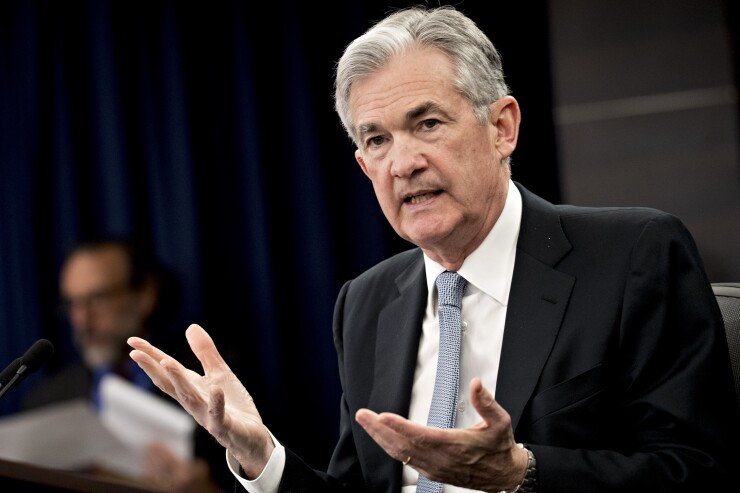Federal Reserve Chairman Jerome Powell said Wednesday that the central bank is “fully prepared” to apply prudential rules to smaller banks even if Congress passes a bill raising the mandatory regulatory thresholds for systemically risky banks to $250 billion.
Speaking during his first press conference since being
That bill would, among other things, raise the asset threshold for banks to be considered systemically important financial institutions, or SIFIs, from $50 billion to $250 billion, but would allow the Fed to apply macroprudential requirements on banks with assets of $100 billion to $250 billion.
But Powell said that the agency is prepared to apply additional prudential scrutiny on banks below the $250 billion threshold. He said the Fed has already designated one bank below that threshold as a global systemically important bank. State Street is the one G-SIB with less than $250 billion in assets.

“We haven’t been shy about doing that, because one of the eight [G-SIBs] is below $250 [billion] already,” Powell said. “We are fully prepared to do that.”
Powell’s comments come as the regulatory relief bill faced stiff opposition from regulatory hawks in the Senate, who argue that raising the SIFI threshold to $250 billion would be tantamount to suspending all post-crisis enhanced supervisory standards on those banks.
Sen. Elizabeth Warren, D-Mass., who led the charge against the bill, said earlier this month that the bill would effectively regulate banks under that threshold as though they were community banks.
“It takes 25 of the largest 40 banks in America — those 25 got more than $50 billion in taxpayer bailouts, nobody went to jail — and it says, ‘Let's regulate them as if they were tiny little community banks that couldn't do any damage to the economy,’ ” Warren said on NBC’s "Meet the Press" on March 11. “Now, let's be clear: a quarter-of-a-trillion-dollar bank is not a community bank.”
Powell touched on another aspect of the Senate bill, which would give the Fed the ability to run one of its two stress tests — the Dodd-Frank Act Stress Test — “periodically” rather than annually. Powell said the Fed has not decided whether to change the frequency in which it runs DFAST even if the bill is passed.
“We haven’t made any decision about that at all. We would want to think very carefully about that,” Powell said. “Whatever we do decide to do, we’d put that out for comment. Is it logistically possible? I would think that it would be, but it’s certainly not something that we’ve decided to do.”
The other stress test, the Comprehensive Capital Analysis and Review, is also run annually on each of the SIFI banks and allows the Fed to restrict dividend payments and compel supervisory improvements if a bank does not retain a minimum capital level. CCAR, unlike DFAST, is based on the Fed’s longstanding supervisory authority and is unaffected by the Senate bill.
Powell also seemed to put a damper on the idea that the Fed might be looking for an opportunity to change the way it conducts its monetary policy, namely by paying Fed member banks interest on excess reserves, or IOER, held in their Fed accounts.
Prior to the financial crisis, the Fed conducted monetary policy through open market operations — buying and selling Treasuries in order to change the money supply. Since the crisis, the Fed has used IOER as its primary monetary policy-setting tool. Some in Congress
“Our current framework for implementing monetary policy is working very well. We have excellent control over rates,” Powell said. “We haven’t made a decision to keep that as our longer run framework; we haven’t really addressed that question. It’s not something we’re looking at resolving in the near term.”
Powell added that part of the reason the decision hasn’t been made is because it remains unclear how much larger the money supply will need to be in a post-crisis world, because many post-crisis regulations require banks to hold on to a larger supply of highly liquid assets, of which Fed reserves are a principle part.
“The size of the balance sheet is going to depend on the public’s demand for our liabilities, including currency in reserves,” Powell said. “So we don’t know what demand is for reserves in a world where you have … regulations that require banks to hold lots of high-quality liquid assets, and reserves are one of those.”
He also pushed back against the idea that IOER provides a benefit to banks at the taxpayers’ expense, noting that the assets against which its liabilities are issued yield a much higher rate than the rate of interest that paid on reserves.
“I think it’s a little bit of a misnomer to think that there’s a subsidy there,” Powell said. “The assets on the other side are Treasury and mortgage-backed securities, which yield much higher than interest on excess reserves. So in fact, it’s not a subsidy and it’s not a cost to the taxpayer.”
Powell’s comments came as the Federal Open Market Committee voted to raise its target federal funds rate by 25 basis points, to between 1.5% and 1.75%.
The highly anticipated rate hike comes as the committee revised its unemployment projections for 2019 and 2020 down to 3.6%. The committee had previously projected unemployment to be 3.9% in 2019 and 4% in 2020. The committee also calculated GDP at 2.7%, up from a 2.5% projection in December. Projections for 2019 GDP were raised to 2.4% from 2.1%, though most of the committee’s inflation projections were effectively unchanged.
The emerging consensus among committee members also appears to center on a year-end federal funds rate of between 2% and 2.5%, suggesting a total of three or four rate hikes in 2018. Of the 15 members currently serving on the committee, 12 foresaw rates within that band.





